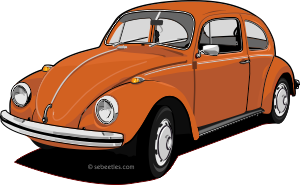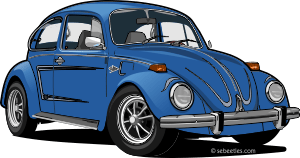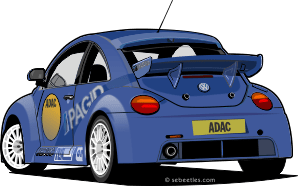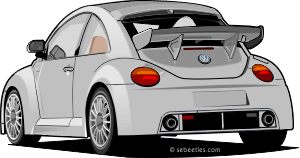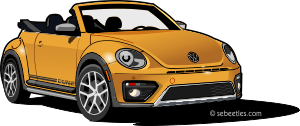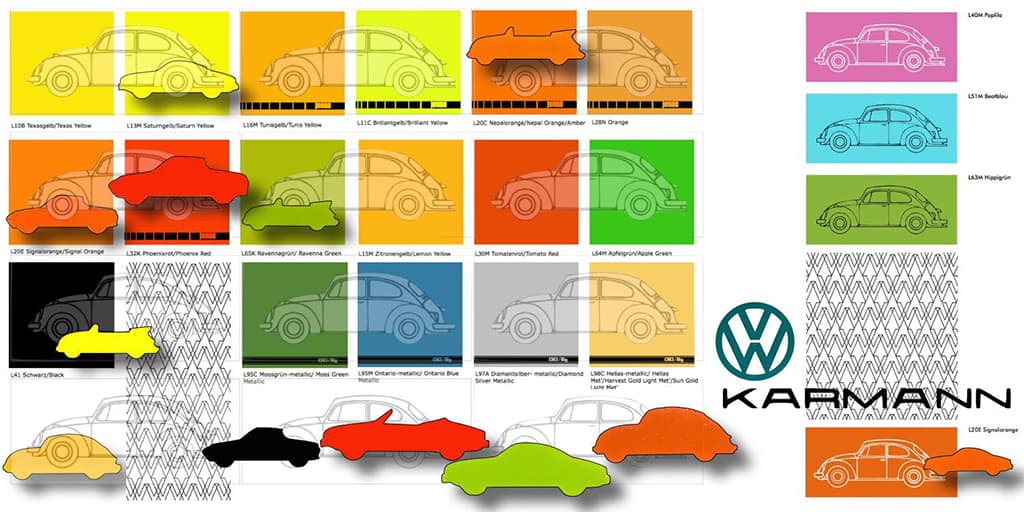
 Information on SEB paint colours has become one of the key resource features of SEBeetles. In this article we provide authoritative information that is not published in such an extensive and complete form anywhere else on the internet - or in printed literature.
Information on SEB paint colours has become one of the key resource features of SEBeetles. In this article we provide authoritative information that is not published in such an extensive and complete form anywhere else on the internet - or in printed literature.
It is a relevant point that whilst Volkswagen were traditionally very thorough in the information provided in each model year’s sales literature for the standard series Beetle model ranges (paint and upholstery availability included) very little similar official information exists for most of the SEB Editions.
Aware of this lack of officially published information our research on the subject of SEB paint and upholstery combinations started in late 2013 and after 18 months resulted in our publishing the first tables of information on this subject in the summer of 2015. The research behind, and updating of, our published information is ongoing: work continuously supported by the input of information from SEB fans worldwide.
Initially, our research resulted in three tables of information: this has now been expanded to comprise of the seven mutually cross-referencing tables P-E.1 - P-E.7 available HERE.
Helping owners.
We are regularly helping owners to establish the original build specification of their Beetles. Sometimes their research is done purely just out of curiosity, sometimes to assist authentic restoration and sometimes because of confusion prompted by some information supplied by the Stiftung AutoMuseum Volkswagen Birth Certificate service.
Establishing the original factory applied paint finish of a Beetle manufactured in Europe often involves no more than a few relatively simple short steps of research.
We hope that the steps we describe in a set of worked examples encourages and helps owners, enthusiasts, restorers and collectors to do similar research about their own cars.
The first worked examples focus on standard model year paint colours followed by examples focusing on SEB colours to illustrate the different type of research they need respectively.
First though some general background on the subject of the paint colours used during European Beetle manufacture between 1961 and 1979 that makes the comprehension of those worked examples easier to understand.
Consistent themes.
The Beetles manufactured in Europe up until 1979 were produced in the Volkswagen GmbH/AG factories at Wolfsburg, Emden, and Hannover as well as being assembled by D’leteren in Brussels, Wilhelm Karmann GmbH in Osnabrück and local assembly elsewhere in Europe - for example in the Republic of Ireland and Portugal.
Up to the 1961 model year Volkswagen used a single, universal, system of identifying paint colours that could be found in parts lists and in sales literature. From the 1962 model year through until cessation of European Beetle production in 1979 Volkswagen used a dual system to identify paint colours. First was the paint’s “L” number (Lack Nr.) and name - often quoted in German language, Second was a code that was used both in the factory production process and also in the sales brochure colour charts printed in Europe. (further reading E.5). This system (which remains in use still today) used a six digit series of numbers and/or letters with numbers that was both the factory production and brochure code. The first pair of digits denoted the main body paint colour, the second pair the roof colour and the third pair the upholstery colour.
It was usual Volkswagen practice to publish separate sales brochure literature for car and paint colours until the 1972 model year when paint and upholstery colours were integrated into the main brochure as the final pages within it.
Each Beetle carried it’s Lack Nr. and name on a small sticker generally found on an inside body panel of the front end storage compartment (boot/trunk). It also carried the first two digits - the body paint code - on a production plate also located on the inside of the boot/trunk.
This small plate riveted to the body panel, and painted with it, is generally to be found close to the locating hole for the bonnet latch as illustrated in the photo below. A full explantion of all the other numbers on the production plate to the right of the paint code and what they reveal about the car are explain together with worked examples in Production plate decoder.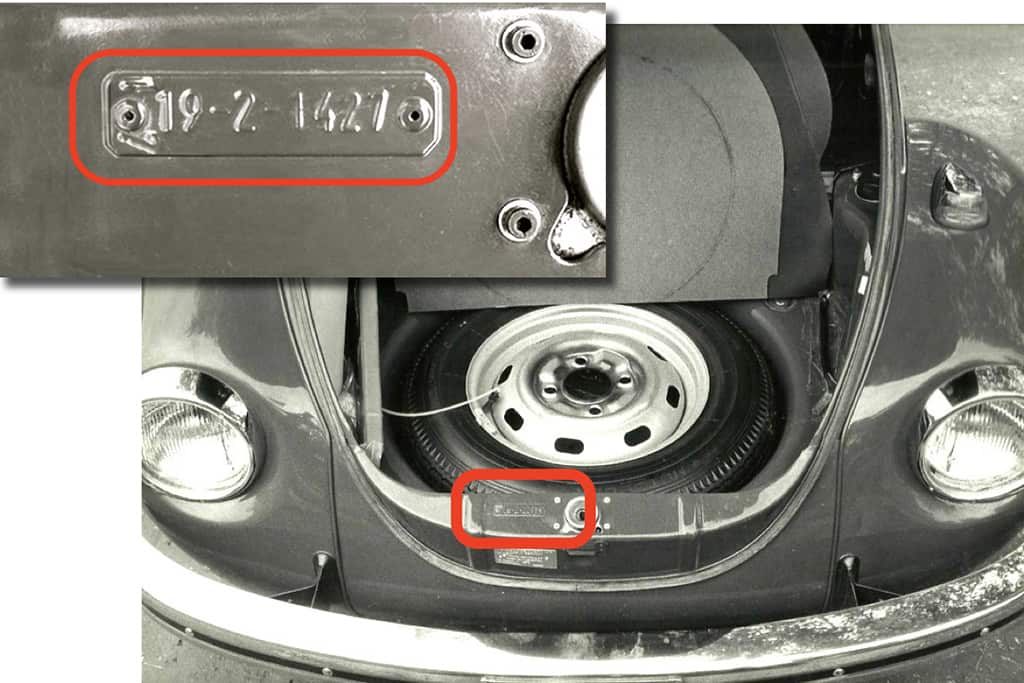
The full six digit production reference number was also included in the data printed on computer print-out slips affixed to the car during production and labels stuck into the Service Record and Diagnostic card booklets. These factory print-outs also include all the extra (“M” and “S”) options installed during production and a lot of other information.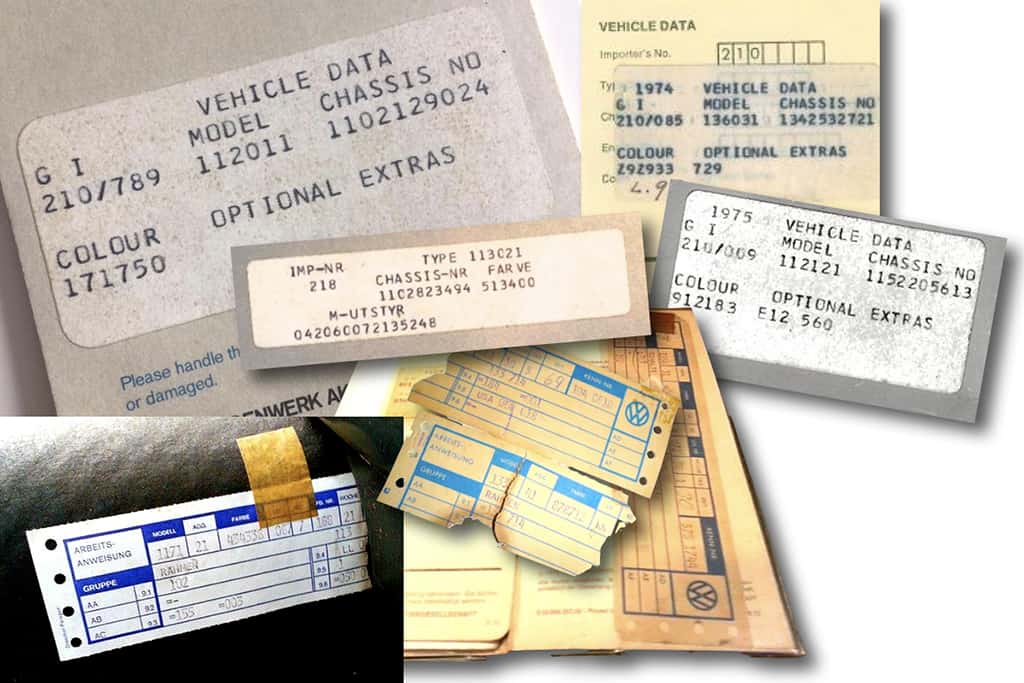
The exceptions to these practices were that production plates were omitted from some later series Beetles and the paint colours of cars assembled on the Karmann production lines were recorded on them by handwritten script - often in places covered later in assembly by trim. An excellent photograph of just such an inscription applied at Karmann can be found in the individual profile for the Sun Bug along with the counterpart sticker applied to saloon (sedan) versions.
The Lack Nr. remained a unique reference number to the paint colour name that it was paired with.
The production/brochure codes however are not so finite. Firstly as the available paint colour choices changed over the years a brochure code would be reassigned to a subsequent colour. To confuse matters even more we understand that the use of the production codes was not consistent throughout Volkswagen’s European factories. A production code used in Wolfsburg for example for a specific Lack Nr. was not necessarily the same code used for that same Lack Nr. in the D’leteren plant even though the use of codes in the brochures seemed universal in all European markets.
Several reference sites can be found on the internet detailing standard series Volkswagen paint colours. Many of them however only detail partial listings of the considerable number of paint colours used since 1945 in Beetle manufacture. A good reference source for both the LackNr. and brochure codes of most of the standard Beetle paint colours is the extensive TheSamba.com website. This website includes two sections that are particularly useful.
Firstly an Archives section that contains a library of sales literature presented in chronological order.
Secondly, a Technical section which includes a lot of information about paint and upholstery combinations.
However, the lists have limitations: the Beetle paint colours go up to (generally) 1972 and predominately only list the standard model year colours.
Beyond 1972 and up until the cessation of European production in 1979 things at Volkswagen got "busy" with the Special (Sales Campaign) Editions and the Karmann produced models using different colours to those used for the standard saloon/sedan models.
Just one more word of caution about using TheSamba’ resource. This excellent website is based in the USA. Much of the literature and terminology is therefore in American English language and uses Volkswagen model descriptions and other colloquial's common to North America. Brochures and colour charts published in North America for the US and Canadian markets can readily be identified by the use of the American English use of the word “color”.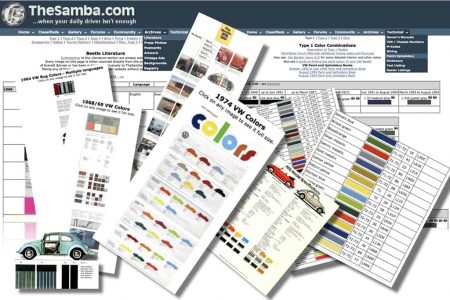
Useful background reading reference that explains the differences between European and North American terminology for Beetle owners on both sides of the Atlantic can be found at E.2 and E.3
A list of the paint colour name changes for the North American market that affect SEB models can be found at P-E.3 HERE.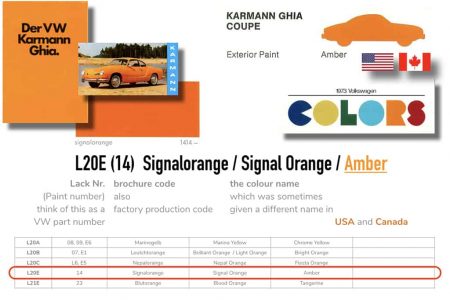
Another valuable research resource of is that of the information from paint manufacturers and suppliers themselves. Traditional paint chip colour cards are easily sourced via internet auction sites and the information is available also on a range of internet websites. The resource we regularly use in our research is that of the Glasurit website. How this resource can be used is illustrated in the worked examples. On the subject of being aware of the limitations of a reference source it is worth noting that the production/brochure code appears in the Aux Code column of Glasurit's tables. For some paint colours there appears no record of the code in their database whilst for other colours which we know have multiple Volkswagen code numbers just one code appears on their display.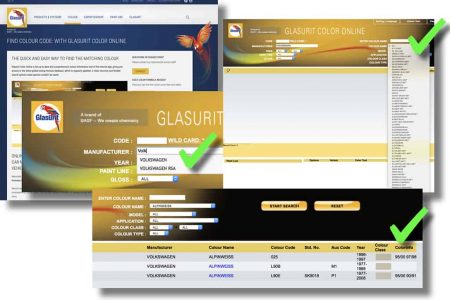
As we have already mentioned by the early 1970’s there was an increasing divergence in hue shades of the paint colours used by Volkswagen on the Karmann built model range as distinct from those used on the mainline Passenger Car model range (including the Beetle saloon/sedan).
The Karmann palette of colours became successively more vibrant and reached a high point the mid 1970’s. This colour range was used not only on the Volkswagen Beetle cabriolet and Karmann Ghias but also on the fabulous, joint venture, Volkswagen Porsche 914 series ... and even on some of the Porsche 911 models.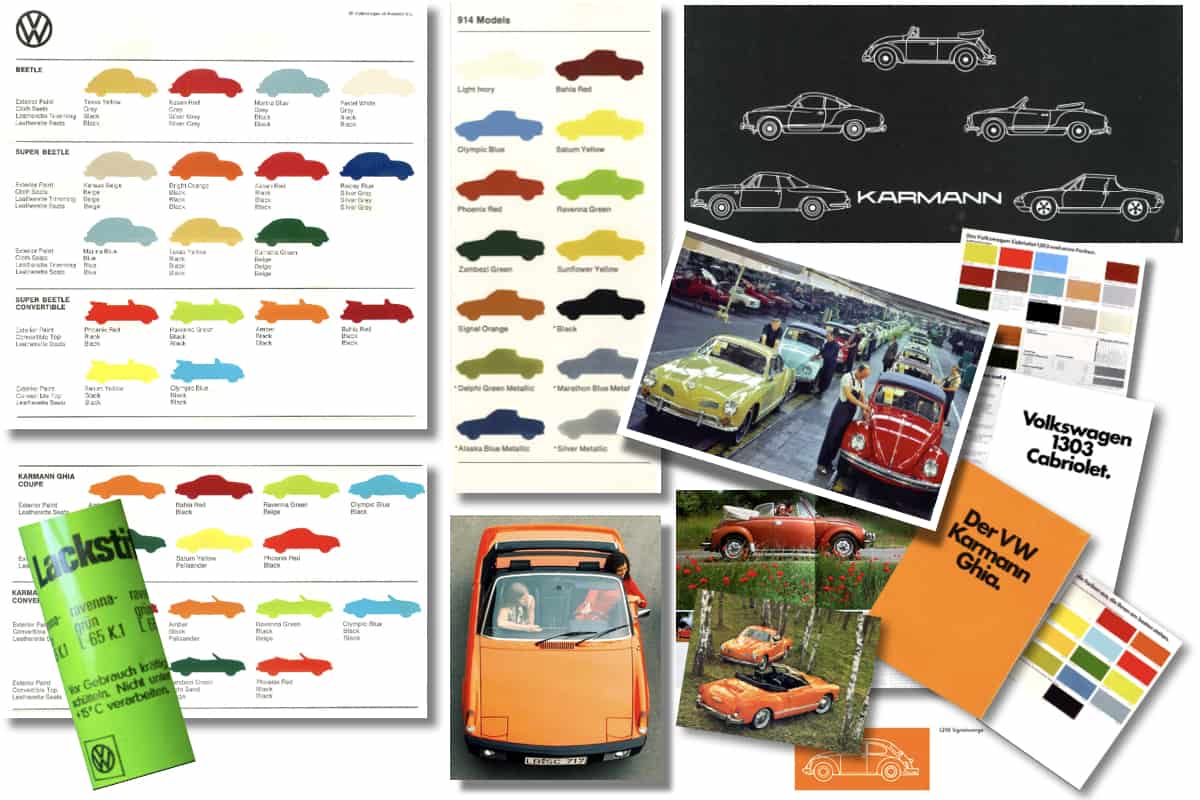
Many of the colours were then also borrowed back, as it were, by Volkswagen’s main factories when manufacturing SEBs.
Irrespective of the motivation behind each SEB package – Celebratory or Sales Campaign - they all had a consistent theme: a distinctive paintwork/trim combination enhanced by additional “M” package items and sometimes also aftermarket accessories all at an effectively discounted total “package” price.
The visible, regular, feature though of most of the SEB editions was those distinctive, non-standard, paint colours.
These non-standard colours used for the SEBs can be divided into three groups:
The first being from the palette of colours used at the Karmann factory in Osnabrück on the Beetle Cabriolet, Karmann Ghias and VW Porsche 914s as mentioned above. This source provided many of the brightest shades. Some, like L21E Blutorange, L32K Phoenixrot and L65K Ravennagrün, were not only popular colours on the Karmann production models but also in SEB production. L13K Sonnengelb on the other had was only seen on one SEB – a rarer Edition for the UK market – despite being a popular colour on Karmann production models notably for the Beetle Cabriolet and VW Porsche 914s.
The second group was a range of colours whose origins are not readily attributable to an obvious source as the Karmann colours are. Some were used elsewhere in the Volkswagen-Audi Group whilst others appear to have been unique to the SEB models. Included in this second group are some rare colours used either in a very limited time period an/or on a very limited number of SEBs. Particularly noteworthy are the “fruit” colours L30M Tomatenrot/Tomato Red and L64M Apfelgrün/Apple Green, for example, being not only colours unique to SEB production but also for the fact that they were “one year only” finishes.
The third group is that of colours that appear to have been mixed especially for SEB production in much the same way that other special paint finishes for emergency and public service vehicle were used to finish Beetles in to special order.
One of the rarest of all the colours used though has, interestingly, become one of the most familiar and instantly synonymous SEB colours - that of L16M Tunisgelb/Tunis Yellow used on the Jeans Beetles.
Even a brief review of the non-standard VW paint colours used for SEB production would be incomplete however without mention of the vibrant “pop” colours L40M Poplila/Pop Lilac, L51M Beatblau/Beat Blue and L63M Hippigrün/HippyGreen used on the very first special production run in the Spring of 1970. The extent of the use of those colours remains, even now, comparatively unknown and very much illustrative of the challenges of ongoing research into SEB production history.
The six tables P-E.1 - P-E.7 illustrate the European production paint colours indicatively, the SEBs on which they were used and the time span of their use within the Volkswagen-Audi Group.
An annotation key is used in table P-E.6 to show where the colours were sourced from as follows:
- K= paint colours applied by Wilhelm Karmann GmbH to Beetle Cabriolets, Karmann Ghias and VW Porsche 914s
- n1 = standard European Volkswagen paint colour for Beetle and other air-cooled passenger car models
- n2 = standard European Volkswagen – Audi paint colour used within the VAG Group on passenger car models
- s = special order paint colours applied in European Volkswagen factories of which other uses within the Volkswagen Group are not known.
Information from the Glasurit website suggests that some paint colours had a much longer period of use within Volkswagen-Audi Group than we had realised before undertaking the research behind our tables – L15M Zitronengelb being a particularly good example.
One area of major frustration is that of the inconsistency in the use of the production coding of many of these colours. The best example of this is L32K Phoenixrot/Phoenix Red which we have, so far, found identified by the following production/brochure codes - 39, 59, G5, H7, and H8. This confusing situation is not helped by the fact that Phoenixrot was initially one of the Karmann palette colours and then briefly, for one year only, a standard Beetle saloon/sedan model year colour also.
The situation is exacerbated by the fact that L30M Tomatenrot/Tomato Red also shares the production/brochure code of 59. This becomes particularly relevant in connection with the Stiftung AutoMuseum Volkswagen Birth Certificate service which appears to identify the built attributes of a car from production code information. As a result we are aware of Birth Certificates containing errors in respect of paint colour - something we have been glad to have been able to provide clarification and correction to Certificate purchaser’s over based on our research.
Another small paint finish related detail that helps identify SEBs is the use of black plastic for the seal/beading strip between the wings and body panels. On all but late production this detail was achieved with plastic matching the body paintwork on series standard European production models.
We presume this use of black trim was a logical rationalisation to ease production complexities and relieve the need of having to manufacture short runs of colour matched strips. The detail does, however, lend a very distinctive small detailing touch to the SEB models and seems to “lift” the visual impact of the paintwork.
1. A standard European Beetle saloon/sedan paint colour. 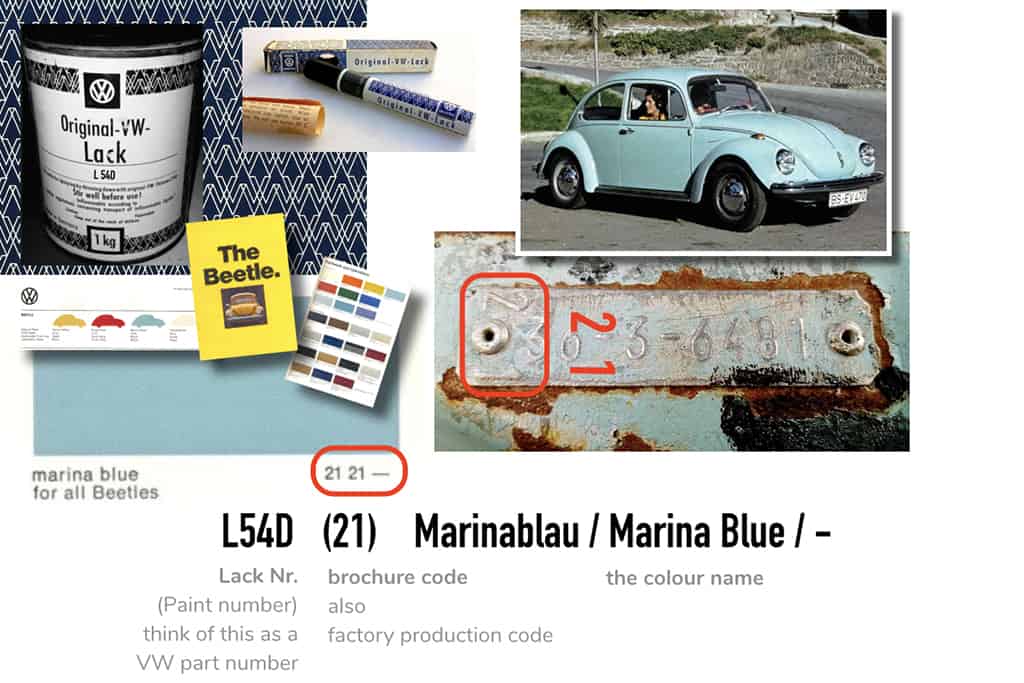
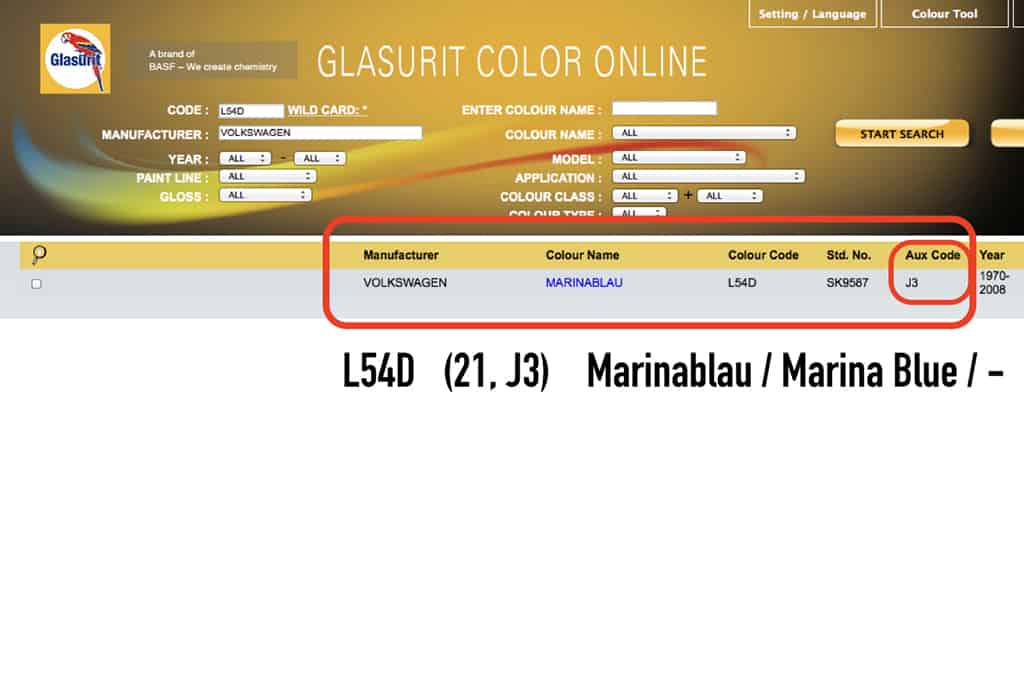
This worked example uses Marina Blue which was a very well known Volkswagen paint colour used right across the Volkswagen Passenger Car range during the early 1970’s. The “Lack Nr.” was L54D.
The illustrations show how these references can easily be picked up out of both the literature and paint sections of TheSamba’ website which show the production/brochure code as 21 — —.
Reference to the Glasurit website site, however, shows the code J3. Production plates on Marina Blue Beetles may therefore carry either 21 and J3 coding.
This illustrates how important cross-referencing is and that neither information source is fully complete. From our research we have drawn up tables P-E.2, P-E.5 and P-E.6 (available HERE) that detail, and cross-reference, production/brochure codes with the Lack Nr.
We believe that these are the only reference sources available on the internet to provide this production code led information. Our tables are still very much “work in progress” as research is continuously ongoing.
2. A standard European Beetle cabriolet/convertible paint colour. 
Extending the illustration of worked example 1 to show how the second and third pair of brochure numbers relate to the top colour and upholstery of the Beetle we have taken a VWoA press photo of a 1500 Beetle so we know the car is in completely original (stock) condition. We can identify that it is a 1500 by the fact that it has Eurobar bumpers and flat windscreen but the narrow pre-1302 bonnet. As such the build period of the model was of a very short timespan. By turning to the Volkswagen colour charts that span the production period we find that only one red paint colour was offered - Königsrot / Royal Red. From these references we can see that the car in the photo conforms to the choice options offered by the sales literature:
Königsrot bodywork paint 17 — —
Silver grey top — 27 —
Black leatherette upholstery — —40
Giving a full production code of 17 27 40.
For a contemporary saloon (sedan) the full production code would have been:
Königsrot main bodywork paint 17 — —
Königsrot roof bodywork paint — 17 —
Black leatherette upholstery — — 40
Giving a full production code of 17 17 40.
3. A standard European Beetle paint colour used on an SEB. 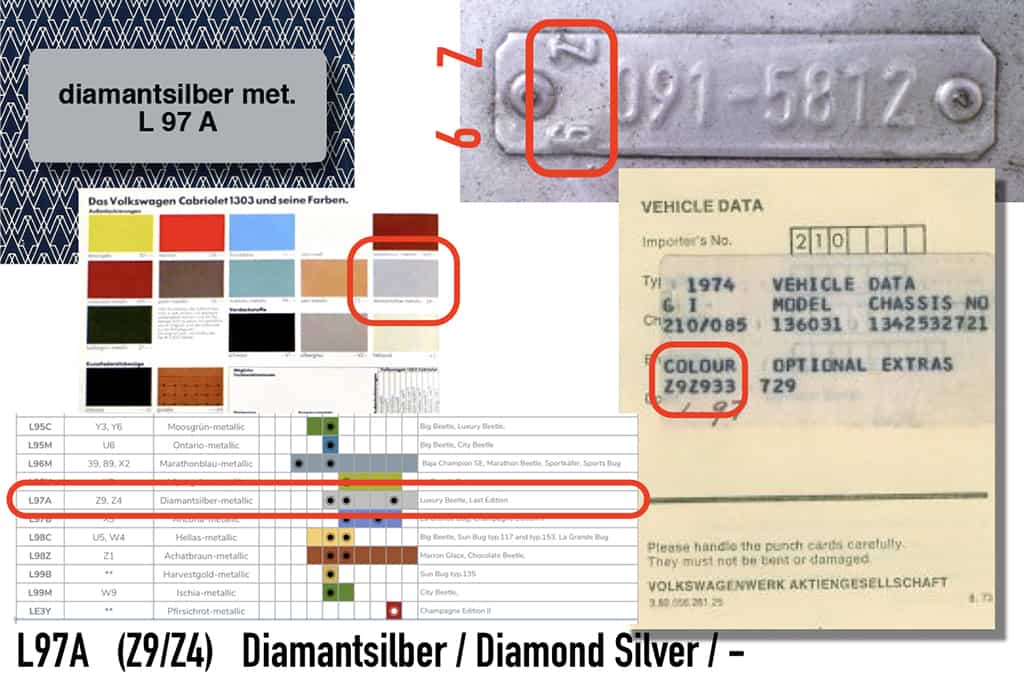
One of the occasions where Volkswagen used a standard European paint colour was with L97A Diamansilber. Our illustration shows how the factory production labels help pinpoint not only the paint colour but also the special edition option number. (In this case 729 which signifies S729 Luxury Beetle.) The production labels also correlate with the production plate and with the small label often fixed to Beetles confirming the Lack Nr. and name.
4. A special European Beetle paint colour used on an SEB. 
Our final worked example takes is the perfect illustration of the rare Volkswagen paint colour Tunisgelb/Tunis yellow used only the Jeans Beetles. Although, unusually for a SEB, there was a Jeans Beetle brochure it did not carry detail of the paint/upholstery code.
Working from the production plates of Jeans Beetles that have not suffered from end damage and still have their plates intact we know they carried the code E9. Using Table P-E.6 we can trace this to Lack Nr. L16M. By using Table P-E.1 the extent of use of Tunisgelb can be easily seen.
To reinforce points made about cross-referencing earlier and the value of the information carried on this website Tunisgelb does not appear in TheSamba.com Technical files section on paint colours and code E9 does not show up against L16M on the Glasurit website.
As more and more owners contact us asking for help to identify whether the Beetle they have is an SEB or not we are finding increasing numbers of former SEBs hiding under later updating and repaints - often with original light clusters, wheels and bumpers changed in line with the ebb and flow of fashions of the day.
Often the identification process is difficult when all original paperwork for the car has been lost over time. In these situations, the fact that the production plate remains on the car is the link to the start of positive identification. With the certain knowledge of the original paintwork colour searches for other clues can begin: checking for scraps of original upholstery material, has the Beetle got distinctive fittings such as a padded dashboard, non standard “Sports” gearshift, traces of wood effect dashboard trim, black plastic beading to the wing/body joints etc.
The finite identification of an SEB without any original paperwork falls to two things - a Volkswagen Birth Certificate and double checking the declarations on that certificate and the evidence from the Beetle itself against the information we provide on the website.
For over 25 years prior to the end of May 2019 Volkswagen Birth Certificates were available via Stiftung AutoMuseum Volkswagen. From the 1st June 2019 they have been available via Volkswagen Classic Parts.
